Have your tomatoes started splitting just before they fully ripen? Are you noticing cracks in your fruit despite doing everything “right” in your garden or greenhouse?
This is a surprisingly common issue for UK gardeners, and while it may seem like a disease or pest problem, it’s actually something else entirely.
Tomato splitting is a physiological disorder, caused by environmental conditions and inconsistencies in how the plants are cared for especially around water, temperature, and nutrients.
This article explains the causes of tomato splitting, the types of cracks you might see, and what you can do to prevent it.
What Causes Tomatoes to Split?
Tomatoes split because of rapid internal expansion, usually triggered by a sudden surge in water. This often happens after a period of drought or dry soil followed by heavy rain or overwatering.
The inside of the tomato swells more quickly than the skin can stretch, leading to cracks in the fruit.
Water Imbalance: The Primary Culprit
The most common reason for splitting is inconsistent watering. If tomato plants are allowed to dry out and then receive a sudden influx of water, the fruit reacts by rapidly swelling.
The skin, especially in ripening fruit, lacks the elasticity to accommodate the internal pressure and begins to crack.
Even watering is essential. If soil dries out too much between watering sessions, the tomato skin hardens. When watering resumes, the fruit expands but the rigid skin cannot adapt, causing splits to form.
Ripening Stage Vulnerability
Tomatoes are most prone to splitting as they ripen. At this stage, the fruit’s skin becomes thinner and more delicate.
If a water surge occurs at this time, it often leads to concentric or radial splits, depending on how and where the internal pressure is exerted.
Environmental Stress: Temperature and Humidity
In British gardens and greenhouses, temperature fluctuations are common. A hot summer day followed by a cool evening or heavy rainfall can stress tomato plants.
The resulting uneven growth and moisture absorption increase the chances of cracking.
Nutritional Factors
Calcium plays a vital role in strengthening cell walls. A deficiency in calcium, often due to erratic watering rather than lack of calcium in the soil itself, can make fruit skins weaker.
This adds to the risk of cracking, particularly when the fruit is close to full ripeness.
What Types of Splits Can Appear on Tomatoes?
Splitting varies in appearance depending on when and how it occurs. Recognising the type can help gardeners identify the root cause more accurately.
Radial Cracking
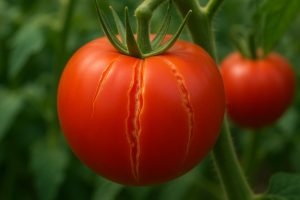
Radial cracks run vertically down the sides of the tomato, often starting at the stem. These are usually caused by water surges during hot and humid weather. The skin tears as the tomato rapidly absorbs moisture and swells outward.
Concentric Cracking
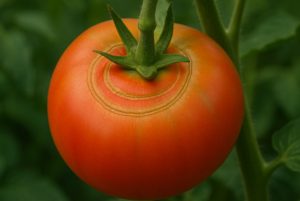
Concentric cracks appear as circular rings around the stem end of the fruit. These tend to develop as the fruit ripens and are often linked to fluctuating water levels late in the growth cycle.
They may appear less dramatic but can still leave the tomato vulnerable to rot and pests.
Though visually unappealing, tomatoes with cracks are still safe to eat if there’s no sign of mould or pest damage.
It’s best to consume them quickly, as the cracks expose the fruit to spoilage and fungal infections, especially grey mould (Botrytis cinerea).
How Can You Prevent Tomato Splitting?
Preventing tomato splitting requires maintaining consistency across all aspects of plant care—especially watering and temperature control.
Maintain Consistent Watering
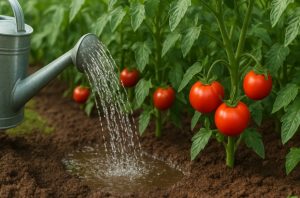
This is the most effective prevention method. Tomato plants should receive about 1 to 2 inches of water per week. Inconsistency especially under watering followed by heavy watering or rainfall must be avoided.
Key tips:
- Water early in the day to allow the soil to absorb moisture without creating overnight humidity.
- Avoid letting the soil dry out completely before watering again.
- Use watering systems that deliver water slowly and directly to the roots.
Improve Soil and Root Conditions
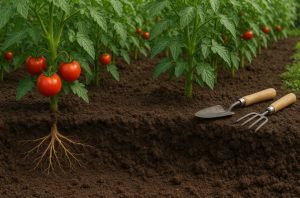
Plants grown in border soil tend to have better access to moisture and nutrients due to their deeper root systems. Conversely, tomatoes in grow bags, containers, or pots are more prone to water fluctuation and therefore cracking.
Strategies:
- Use high-quality compost or potting mix with good water retention.
- Ensure containers have proper drainage to avoid waterlogging.
- Monitor soil moisture frequently, especially in hot or windy conditions.
Use Mulch to Retain Moisture
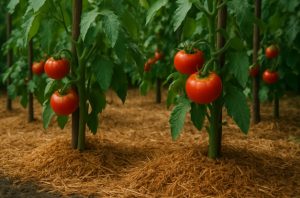
Mulching helps keep the soil consistently moist and reduces surface evaporation.
Common mulch options include:
- Straw
- Compost
- Shredded bark
Mulch also buffers the soil against sudden changes in temperature, especially helpful during the British summer.
Address Nutrient Deficiencies
Although rare, calcium deficiency can contribute to weak cell walls, increasing the risk of splitting. This is often a symptom of inconsistent watering more than a true lack of calcium in the soil.
Consider testing your soil and adding supplements like bone meal if needed. Use a balanced tomato feed with adequate potassium to support fruit development and skin resilience.
Manage Greenhouse Conditions

In greenhouses or conservatories, temperature and humidity must be managed carefully to prevent stress on plants.
| Growing Environment | Preventive Measures |
| Greenhouse/Polytunnel | Use ventilation, white shade paint, and thermometers |
| Outdoor Garden | Mulch, water regularly, harvest fruit before heavy rain |
| Pots/Grow Bags | Monitor moisture daily, use drip irrigation if possible |
In greenhouses, lack of airflow and rising humidity can lead to fungal infections, especially if fruit is already split. Proper ventilation is critical, and some gardeners opt to temporarily remove panels or lift tunnel sides to improve airflow.
Is Tomato Splitting a Sign of Disease?
No, tomato splitting is not caused by pathogens. It is a physiological disorder, resulting from environmental conditions such as watering practices, temperature swings, and nutrient uptake.
While cracked fruit may look concerning, the underlying issue is about plant stress rather than infection. However, splits can allow fungal diseases to take hold, so prompt harvesting of affected fruit is advised.
Additional Symptoms Linked to Environmental Stress
| Symptom | Likely Cause |
| Corky scars (‘catfacing’) | Temperature fluctuations during fruit set |
| Uneven ripening | Low temperatures and short daylight hours |
| Russeting (rough skin) | Variable humidity and inconsistent watering |
Towards the end of the growing season, the combination of cool nights and shorter daylight makes it difficult to avoid conditions that lead to fruit splitting.
During this period, it’s best to pick tomatoes early and let them ripen indoors in a warm, dark location.
FAQs About Tomato Splitting
Can tomato splitting be reversed once it starts?
No. Once a tomato has split, the damage is permanent. However, you can stop it from spreading by harvesting the fruit early and adjusting your watering routine.
Should split tomatoes be composted?
Only if they are free of disease. If the cracks have led to mould or pest infestations, it’s better to discard them entirely to avoid contamination.
Is catfacing the same as splitting?
No. Catfacing causes deformed fruit due to temperature fluctuations during fruit set. Splitting happens later and is caused by moisture imbalance.
Can a greenhouse completely prevent tomato cracking?
Not completely. While it offers more control over temperature and moisture, issues like poor ventilation and overwatering can still lead to cracking.
What time of day is best to water tomato plants?
Morning is best, as it allows plants to absorb water before temperatures rise and helps reduce overnight humidity, which can promote fungal diseases.
Do all tomato varieties split equally?
No. Some hybrids are bred to be crack-resistant. Heirloom varieties, while flavourful, are more prone to splitting due to thinner skins.
How does calcium affect tomato skin?
Calcium strengthens cell walls. Inconsistent watering can reduce calcium uptake, even if the soil contains adequate levels, making skins more fragile.






